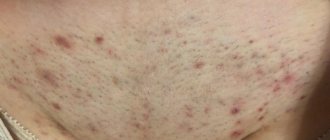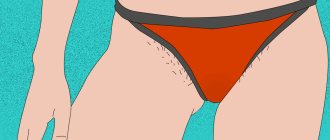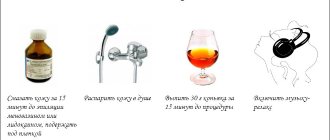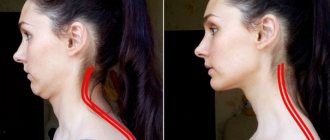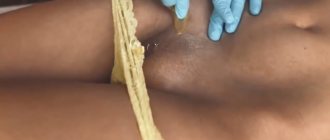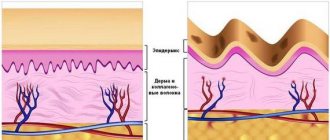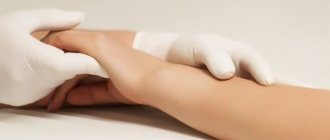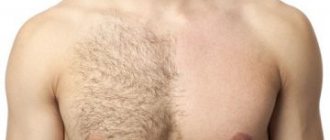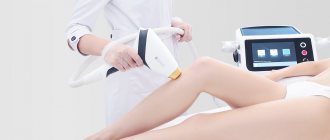Women get rid of unwanted hair in a variety of ways. However, after the removal procedure, new hair becomes stiffer and often grows in, which is accompanied by inflammation. This disease is called pseudofolliculitis.
It brings aesthetic and physical discomfort. This especially happens in the bikini area, since the hair here is coarser than anywhere else. They get rid of them using traditional methods, peelings, scrubs and special preparations, including homeopathic ones.
How to remove ingrown hairs
Scrubs, peelings, folk remedies are the first aid for the appearance of ingrown hairs. If there are a lot of them, then removal will take a lot of time. The easiest way to solve the problem is if two, three, or four hairs have grown in.
To do this, you need to avoid hair removal by any method for 2-3 weeks, and include the use of scrub or peeling in your skin care to exfoliate dead cells. Squeezing or picking out hair is not recommended, as these traumatic actions contribute to the spread of infection.
Mechanical removal is done as follows:
- Take a bath with hot water or steam the skin by applying an application of a towel soaked in hot water. This leads to the opening of the pores, making the procedure easier.
- Then you should use a scrub or peel to remove skin flakes that clog your pores.
- Then you need to treat the skin with an alcohol-containing liquid or a special product with disinfecting properties. Use the same product to wipe tweezers. Using the tool, carefully pry the hair and pull it out by the tip.
- If you need to remove more hairs, then treat your hands and tools again.
To prevent the development of inflammation, it is necessary to wipe the skin with a disinfectant composition or lubricate it with antiseptic ointment for two days.
Important! If a lump or abscess has formed at the site of the ingrown hair, you cannot use the mechanical method of hair removal.
How to properly get rid of ingrown hairs?
If the twisted ring is clearly visible through the epidermis, it means that it is located shallow. Hair can be carefully removed, but only if there is no inflammation or pus. To do this, the affected area is steamed in warm water or a decoction of chamomile or string. Then thoroughly wipe with alcohol or any antiseptic (for example, Chlorhexidine). Hands must be washed and also disinfected.
Using a thin needle from a disposable sterile syringe, carefully pierce the skin and pull out the hair. After this, it is grabbed with disinfected tweezers and pulled out (do not pull out, so as not to damage the bulb) strictly in the direction of growth. Finally, the wound is treated with hydrogen peroxide and lubricated with antibacterial ointment (Levomekol, Metrogyl). The bikini area is not shaved or epilated until the damaged area is completely healed.
How to prevent ingrown hairs
The skin in the bikini area is sensitive and thin.
To prevent ingrowth, as well as the accompanying inflammatory process, it is necessary:
- choose the optimal method for removing vegetation;
- follow the removal technology;
- use a scrub or peeling, these products help break through already ingrown hair shafts and prevent others from ingrown;
- avoid exposure to ultraviolet rays, as ingrowth occurs more intensely;
- use a skin product with moisturizing properties;
- Do not use sharp objects to remove hair, such as needles.
Features of the bikini area
The intimate area is different from other areas where vegetation is removed.
- the hair is very coarse, especially if the lady is naturally dark or red-haired;
- the skin in the bikini area is thin, blood vessels pass close to the surface, and immediately begins to become inflamed;
- high sensitivity in the area between the legs;
- uneven surface for cosmetic procedures;
- constant contact with clothing;
- special, triangular hair structure.
Ingrown hairs are new hair shafts that, as a result of damage to the hair follicle, begin to grow not in the natural direction, but down or to the side. They need to be pulled out from under the skin. Through micro-wounds and cracks in places of growth, microorganisms enter the body, causing pathological processes. All this provokes an inflammatory process that can lead to ulcers, bumps, scars and dark spots.
When epilating, a woman plans to remove hair along with the hair follicles. If something goes wrong, only the shaft and part of the follicle are torn off. As a result of mechanical damage, the position of the hair root changes, and soon a weakened hair appears, which grows not in the intended direction, but in the direction where the bulb has deviated, even growing inside the body. And those rods that do reach the skin, due to thinning, cannot penetrate the epidermis and grow under it, causing inflammation.
How to remove hair correctly so that it does not grow in
Each hair removal technique requires certain rules. The razor cuts the hair, so the hairs become sharp at the end. This causes additional skin irritation.
If removal is carried out by shaving, the skin must first be steamed. The hair is then cut with a razor according to the hair growth.
If the waxing procedure is carried out, it is applied to dry skin, which should first be cooled. The composition is torn off against hair growth.
When using sugar paste, it is applied to the skin treated with talcum powder against hair growth, and torn off along the growth.
Prevention
To prevent such problems, you should remember the following rules of prevention:
- Choose the right hair removal method. It's better to leave this to the professionals. If you remove it yourself, you should definitely carry out a procedure to soften and exfoliate the skin. The razor for removal should be sharp, and depilatory creams should be of high quality. You should not use shaving machines for a long time: this increases the likelihood of ingrown hairs.
- Shave hair in the direction it grows. When shaving, you should use foam or other special products.
- Use special lotions and creams after hair removal.
- Do not wear synthetic underwear after hair removal.
- Observe all rules of personal hygiene.
Depilation
Ingrown hairs in the bikini area after shaving are less likely to appear if you use a sharp razor. This will greatly facilitate and speed up the procedure. For shaving, hair about 1 mm long is optimal. Before getting rid of long hairs, it is recommended to cut them first.
- Before shaving, take a hot bath.
- Then the skin is scrubbed.
- Shaving cream is applied to the bikini area to be treated.
- Remove vegetation with a razor.
- Each time you pass the instrument over the surface of the skin, rinse it under running water.
- After finishing shaving, wash off the remaining cream and hair.
- The skin is dried, hands and bikini are treated with an antiseptic.
- To make hair growth slower, lubricate the skin with a special product.
- If the skin is irritated, you should use an anti-inflammatory ointment.
- If a cut occurs, you must immediately disinfect it by washing off the shaving cream and stop the bleeding with a cotton swab.
The effect of depilation lasts only two to three days.
How to deal with the problem?
Based on the severity of the problem, ways to solve it can be different: from simple home methods to surgical intervention.
Steaming the skin
This procedure makes it easier for hairs to come out. You need to soak the cloth in warm water and apply it to the place where the hair has grown. Repeat several times. There is a folk method when bread and warm milk replace cloth and water. Continue this until the top layer of skin becomes loose and the hair can be easily removed.
Scrub or peeling
The scrub is applied on the 4th day after hair removal and then after 2-3 days. Be sure to lubricate your skin with moisturizer after using the scrub.
One effective way is to use anti-acne lotions. They contain salicylic acid, which helps exfoliate dead skin. Peeling can be used after hair removal to prevent ingrown hairs.
Removal with a needle
Doctors do not recommend pulling out ingrown hairs in the bikini area yourself with a needle. This can cause a purulent infection. Therefore, you can remove only those hairs that are noticeable on the surface of the skin and do not have purulent inflammation. Before removing the ingrown hair, the area around it and the tweezers should be treated with alcohol. It is better to take a sterile needle from a syringe. Use it to carefully pry up the hair and release it. Then pick it up with tweezers and pull it out. The remaining wound should be treated with alcohol and an ointment containing an antibiotic should be applied to it. After the procedure, you cannot do hair removal for several days.
Professional help
Ingrown hair removal is included in the list of standard services of many beauty salons. It is advisable that the removal method be chosen by a dermatologist, taking into account the properties of the skin and hair.
- Bioepilation is a gentle method. This also includes sugaring and depilation with wax. But this method does not always give the desired result.
- Photoepilation - in this case, the hair absorbs light and conducts it to the bulb, destroying it.
- Laser hair removal – the follicle is destroyed under the influence of a laser beam.
- Electrolysis – the effect is carried out using electric current.
The last three methods are non-contact and safe options. But they are contraindicated for pregnant women, breastfeeding women, and people with any formations on the skin.
Surgeon's help
If the ingrown hair has become a lump that is located under the skin and constantly changes its size, then you need to seek the help of a surgeon. Such symptoms indicate a wave-like process of suppuration in the follicle, which explains the increase and decrease in the size of the lump.
This process will not happen on its own. This requires drainage of pus. It happens that the subcutaneous abscess opens on its own. Then, simultaneously with the pus, the hair itself comes out of it. But the inflammatory process can affect neighboring tissues and cause an abscess. The risk of getting an abscess appears when you independently try to open the lump with a needle or squeeze it out with a fingernail. Then surgical intervention cannot be avoided.
If you doubt that you know how to remove ingrown hairs, it is better to consult a doctor. It is also necessary to do this if independent attempts to remove hair lead to suppuration. The following actions will be carried out in the medical office under the supervision of professionals:
- The abscess is opened using a scalpel or needle.
- pus and ingrown hair are removed.
- the wound is washed with an antiseptic.
- Antimicrobial ointment is applied to the wound using a sterile bandage.
But if hair grows too often, what should you do in this case? After all, you can’t run to the doctor with every hair. You need to know some folk recipes and use them regularly.
Waxing
Waxing is more painful, but its effect lasts for almost a month. Irritation and inflammation after the procedure are not uncommon, so it is important to follow the rules of skin care.
- The skin must first be treated with an antiseptic, however, it must be dry.
- The wax is prepared: heated in a steam bath or in a special device and distributed in a thin layer in the direction of hair growth.
- Then a strip is placed on top, the composition is allowed to set, and with a sharp movement against the growth of vegetation, it is torn off.
- The entire bikini area is treated in this way.
- Then anti-inflammatory agents are applied.
In the first days, you need to lubricate the hair removal area with antiseptic ointment. Peels and scrubs are not used for 5-7 days.
Causes of ingrown hairs on legs
Ingrown hairs on the legs can form on any part of the skin. The fundamental reasons for the development of this problem include:
Hair structure. If a person has hair on his legs that is black, has a curly structure and is stiff, then the development of the problem of ingrown hairs after shaving is very high. Dense layers of the epidermis. If a person has a dense epidermal layer, then it is quite difficult for growing hairs to make their way out, which is why the phenomenon of ingrowth occurs. Hormonal imbalances. The cause of the negative phenomenon is also an increase in the level of the hormone estrogen, which is produced in large quantities during puberty and the menstrual cycle. If the epidermis is not properly prepared for depilation. Before hair removal, preliminary preparation of the epidermis for this process plays an important role. Preparation includes the process of exfoliating the keratinized layers of the epidermis, which is carried out using various scrubs. If you use depilatory tools incorrectly. If you use razors with dull blades to shave leg hair, this will certainly become the main reason for their ingrowth into the skin. During shaving, dull blades do not do their main task well, so to thoroughly remove hair, you have to use the razor over one area more than 2 times. This leads to irritation appearing on the skin with further transition to an inflammatory process. Inadequate skin care after hair removal. After cleansing the skin of excess hair, it is imperative to use special preparations for moisturizing and disinfection. If the skin is not treated, bacteria will enter the upper layers of the epidermis and provoke the development of an inflammatory process.
It is through inflammatory processes on the skin that consequences such as ingrown hairs are formed. Wrong choice of clothing After shaving your leg hair, it is important to pay special attention to your clothing. If you wear tight-fitting clothing, this will certainly contribute to hair ingrowth into the skin. It is necessary to wear loose clothing not only after the depilation procedure, but also constantly so that the skin can breathe.
If, after epilation, ingrown hairs form on the legs, it means that one or more points of the above reasons have been violated. How to get rid of such a negative phenomenon, which not only causes discomfort, but also makes your legs ugly? To do this, let’s look at the main ways to solve this problem.
What is the best way to remove hair?
There will be fewer ingrown hairs in the bikini area if you choose the right way to get rid of them. Experts recommend sugaring, since shaving involves frequent processing of the specified area, and this is undesirable. The most preferred frequency of vegetation removal: once every 2 weeks.
Mechanical depilation using an epilator is also undesirable, as the skin is injured. After exposure to the device, the direction of growth of hair shafts changes, which only contributes to the formation of ingrown hairs. Sugaring, unlike the listed methods, is a more delicate method of hair removal.
Ways to deal with the problem
Ingrown hairs appear in the bikini area after depilation much more often than in other areas of the body. This is due to the characteristics of the skin in this area. There are several methods you can use to fix the problem.
Using scrubs
If no inflammation has formed around the ingrown hair, then the skin can be treated with a scrub to remove it. First you need to steam the skin. To do this, you can take a hot bath or apply it to the problem area for 10 minutes. a towel soaked in hot water (58–60 °C) or herbal decoction.
It is recommended to prepare a decoction from chamomile, calendula or sage: 1 tbsp. l. pour 0.5 liters of boiling water over the herbs and put on fire for 15 minutes. After this, cool the broth to 58–60 °C, strain and use as directed.
Apply the scrub to the steamed skin and work it in a circular motion. Abrasive particles help remove the stratum corneum. This way, the ingrown hair will be free. You just need to remove it with tweezers.
At home, you can easily prepare a scrub yourself. To do this you need to mix 1 tbsp. l. spoon of shower gel with 1 tbsp. l. abrasive particles (bran, salt, sugar or ground coffee beans).
Ground coffee in a scrub can effectively prevent inflammatory processes
If you use a purchased scrub, then its effectiveness can be significantly increased by adding baking soda to it: by 1 tbsp. l. scrub should take 1 tsp. soda
Using a needle and tweezers
In the case when inflammatory processes have arisen around the ingrown hair, the resulting suppuration cannot be squeezed out. This can lead to the hair follicle being severely damaged by mechanical stress, and subsequently ingrown hairs will appear from it within 1.5–2 months. Therefore, you need to remove the problem in the following sequence:
steam the skin in a hot bath or with a compress; disinfect the problem area with alcohol, hydrogen peroxide or chlorhexidine; treat a thin needle with a bactericidal solution; carefully puncture the purulent formation; use the end of the needle to pry the hair and bring it out; remove hair with tweezers; treat the wound with a disinfectant; Lubricate the skin with an antiseptic for 2-3 days.
Video: removing ingrown hairs with tweezers
https://youtube.com/watch?v=yJqa_aa3AoQ
Components that soften the top layer of skin
Some women are scared even by the thought that an ingrown hair should be removed using a needle. In this case, the skin must be treated with substances that soften the stratum corneum, make it thinner, and this prevents ingrown hairs.
Salicylic acid
Under the influence of salicylic acid, the stratum corneum of the skin peels off easily. That is why this component is included in many cosmetic peels. Salicylic acid prevents the appearance of inflammation and also promotes the rapid healing of existing pustules, since it has an antiseptic and anti-inflammatory effect on the skin.
To eliminate purulent pimples in areas of ingrown hair, you must use a two percent solution of salicylic acid. Within 4–5 days, areas of inflammation should be cauterized pointwise using a cotton swab. During this time, the dead skin cells will peel off, and the ingrown hair will appear on the surface of the skin. You just need to carefully remove it with tweezers. After hair removal, the ingrown area must be disinfected.
Salicylic acid has the ability to soften the stratum corneum
Aspirin remedy
An ingrown hair can be effectively pulled to the surface of the skin using acetylsalicylic acid. To do this, 2 aspirin tablets need to be crushed into a fine powder and mixed with 1 tbsp. l. glycerin. The resulting mixture should be applied to the problem area and left for 2–2.5 hours. The loose hair must be removed with tweezers, and the skin must be treated with an antiseptic.
Composition of badyagi and hydrogen peroxide
An effective remedy for ingrown hairs is a mixture of badyagi powder and hydrogen peroxide. You need to mix 1 tsp. each of the components. Apply the resulting mass to the affected area. During the procedure, a slight tingling and even burning sensation will be felt, so after 10–15 minutes. the composition must be washed off with water at room temperature and moisturize the skin with cream.
The procedure should be carried out for 5 days, after which the hair should appear outward and must be pulled out with tweezers.
Rules of regimen and care after hair removal
- Immediately after the procedures, you should wipe the skin with an antibacterial agent.
- Moisturizers and nourishing products should be used, but only after the irritation has passed.
- On the 1st day after the procedure, water procedures are not recommended, either in the bathtub, shower, or in open bodies of water.
- Clothing should be chosen from natural fabrics.
- The cut of clothing should eliminate friction in the treated area.
- 1-2 times a week, no more often, starting from 2 weeks. after hair removal, scrubs and peelings are used. After using them, the skin needs to be moisturized: lubricate with cream, milk or oil.
- Professionals recommend using a scrub in preparation for hair removal, and after the procedure give preference to peeling. It is important to remember that any composition can cause an allergic reaction, therefore, before applying to the treated area, the composition is checked by applying a small amount of it to the crook of the elbow.
- The scrub is distributed with massage movements for 2-3 minutes, then washed off with water.
Don't miss the most popular article in the section: Laser hair removal on the face and body - how it is done, effectiveness, before and after photos, contraindications.
Preventive measures
It is easier to prevent any problem than to solve it later. Therefore, it is necessary to follow some recommendations to avoid ingrown hairs and the resulting unpleasant consequences in the form of bumps, boils, and bruises.
- 12 hours before depilation, it is necessary to treat the bikini area with a light scrub, as a result of which the stratum corneum will become thinner and the hairs will become longer. Consequently, during depilation, hairs will be more securely captured and more easily pulled out of the skin without breaking.
- Immediately before and after the procedure, the skin should be disinfected to reduce the risk of inflammatory processes.
- 24 hours after depilation, skin in the bikini area should be treated with products that minimize the likelihood of ingrown hairs. These products contain components that eliminate the upper keratinized layer and effectively slow down hair growth (Aravia Professional AHA-cream post-epil lotion with AHA acids, Velvet lotion, etc.).
Velvet lotion prevents the appearance of ingrown hairs and prolongs the depilation effect
- In order for new weakened hairs to break through, the skin must be treated with a scrub regularly (2 times a week).
- In the first 2-3 days after depilation, it is not recommended to wear tight underwear, as this can provoke a change in the position of the follicle, and then the hairs emerging from it will grow into the skin.
- It is not recommended to visit saunas, swimming pools and the gym for 2-3 days after the hair removal procedure, because the skin injured during depilation is too susceptible to bacteria and microbes.
Depilation of the bikini area is most often accompanied by ingrown hairs, which is due to the characteristics of the skin in this part of the body. Sometimes purulent inflammations appear around the ingrown hair, developing into serious forms (boils). The problem of ingrown hairs, as well as blue spots after them, can be solved with the help of pharmacy and home remedies. But it is best to follow recommendations that minimize the risk of ingrown hairs.
- Author: woman
Rate this article:
- 5
- 4
- 3
- 2
- 1
(30 votes, average: 4 out of 5)
Share with your friends!
Which doctor should I contact?
If the condition of the skin causes concern (there are many purulent abscesses, or they increase in size, covering new areas of the skin), you need to consult a cosmetologist or dermatologist, and subsequently for surgical help.
Ingrown hair that remains under the skin is unable to resolve on its own and provokes even greater inflammation. Sometimes the abscess breaks open without help. Then the wound must be treated with antibiotics and then covered with a sterile bandage.
Depilation in the salon
Many young ladies who do not want to take risks entrust the care of their own bodies to a master. On the one hand, this is correct, but on the other... Oddly enough, sometimes a trip to the salon results in unnecessary costs and headaches. And the reasons are banal:
- low level of qualification of the master;
- lack of preliminary preparation;
- use of cosmetics that are not suitable for the client’s skin type.
To avoid such troubles, you should visit only trusted centers and not save on yourself, your loved one. It is much more effective and healthier to visit a highly professional cosmetologist, who, using modern techniques, will relieve you of excess “vegetation” for a long period. And then recommendations on how to get rid of ingrown hairs will become irrelevant.
Scrub and peeling recipes
Ingrown hairs in the bikini area (how to get rid of them at home are discussed below) are recommended to be treated using home remedies. They need to be used in advance, without waiting for the ingrown hair to fester.
Try using a coffee scrub to get rid of ingrown hairs in your bikini area.
- Natural coconut oil is added to the coffee scrub, which helps moisturize and nourish the skin. Coffee directly functions as a scrub in it. 2 tbsp. The butter should be melted over low heat in a water bath and cooled until warm. Then add 1 tbsp. coffee, salt and sugar. All ingredients are mixed with wooden cutlery. Use as intended.
- A coffee scrub can also be prepared according to a simpler recipe, combining ground coffee with olive oil. The effect will also be good.
- 3 tbsp. olive oil is mixed with 2 tbsp. honey (liquid or candied), add 2 tbsp. sugar and a few drops of lavender essential oil.
- 3 tbsp. aloe juice, squeezed from leaves, mixed with 3 tbsp. corn flour and mix thoroughly.
- 3 tab. knead aspirin and pour 2 tbsp. water. The composition is applied to the skin using massaging movements. Then wipe it with 3% hydrogen peroxide.
- 1 tbsp. soda diluted with 2 tbsp. warm water, rub in, then leave for a couple of minutes and rinse with water. After the procedure, cream is applied.
- Combine 2 tbsp. white clay with 1 tbsp. parsley juice, add 3 drops. freshly squeezed lemon juice and apply the composition. After 10 minutes, wash off with water. This composition will help against hyperpigmentation.
- Combine 3 tbsp. sea salt and 1 tbsp. lean or olive oil.
- Take 3 tbsp. sea salt, 1 tsp. freshly squeezed lemon juice, 1 tbsp. ground coffee, 1 tbsp. olive oil.
- Mix 3 tbsp. sea salt, 1 tbsp. cosmetic oil and chopped orange zest, add 2 drops. lemon and grapefruit extract.
- Combine 1 tsp. vegetable oil with 1 tbsp. sea salt and 1 piece of grapefruit, crushed in a blender along with the peel.
- Mix aspirin tablets with glycerin: 1 tsp. both components. The treatment procedure is carried out, then the ingrown hairs are mechanically removed using tweezers.
- To prepare an oatmeal scrub you will need 3 tbsp. crushed rolled oats into powder, to which you need to add fat sour cream and honey in equal quantities until it reaches a consistency convenient for application. After treating the bikini area, the composition is washed off with water.
- It’s even easier to treat the skin with sugar. It is applied to steamed, moistened skin after a shower.
- A scrub made from fine salt is similar in effect. You will need 3 tbsp. salt, which, like sugar, should be rubbed into the problem area and then washed off with water. Salt has antiseptic properties.
If the ingrown hair is already breaking out, then you cannot use scrubs and peels.
Powerful aspirin scrub
Crush several tablets of acetylsalicylic acid into grains. Add tablet crumbs to a small amount of liquid soap. Apply the paste with a light massage to the depilation area, avoiding areas with mucous membranes. After a few minutes, rinse off the mixture and wipe the treated area with 3% hydrogen peroxide. Let it dry, rinse off any remaining product, and apply nourishing cream.
Strong whitening peeling
Mix 50 g of white clay with ground parsley. Add a couple of drops of lemon juice. This composition whitens the skin well. It is applied for 10 minutes, after which it is washed off with warm water.
Folk remedies
Ingrown hairs in the bikini area (how to get rid of them step by step mechanically is discussed) can also be removed using folk methods:
- Inflamed areas are spot-treated with toothpaste or tooth powder diluted with water. The composition is left for 30 minutes to dry and then washed off.
- Olive oil will help soften the skin, allowing hair to break through to the surface of the skin. Lubricate the bikini with heated olive oil and leave for 30 minutes, then rinse with water.
- Badyagi powder is diluted with 3% hydrogen peroxide to form a paste. It is applied for 15 minutes every day for a week.
- Salicylic acid can be used to spot treat ingrown hairs to reduce inflammation. You should use the composition for 5 days so that the hairs come out on their own. Since salicylic acid dries the skin very much, you need to rub in a moisturizer after the procedure.
- According to traditional methods, it is necessary to use a compress from a baked onion. The onion is baked, then cut in half and applied to the inflammation for 3 hours, after this time you need to cut off the thin layer that was in contact with the skin and make a compress again. According to reviews, such actions quickly lead to the opening of the abscess.
- Homemade onion ointment is prepared like this: bake one onion, turn it into a paste, add 1 tsp. liquid honey and flour. The resulting gruel is used to lubricate the inflammation up to 5 times a day.
- Another remedy that includes baked onions is a compress with the addition of grated laundry soap. Take 1 part soap for 2 parts of onion and apply directly to the area of inflammation.
- A more convenient remedy is powder made from powdered pink frankincense petals and aloe leaves. This powder helps relieve inflammation. It should be used 5 or more times a day.
- You can use apple cider vinegar to treat your skin.
Eliminating Blue Spots
Quite often, after removing an ingrown hair, unsightly dark spots of a bluish or brown tint form in its place, and the bikini area takes on an unsightly appearance. This problem can be solved using pharmacy and home remedies.
Salicylic-zinc paste
The product has an effective whitening effect on the skin. Therefore, it can be used when skin pigmentation occurs after ingrown hairs. However, it is worth noting that salicylic-zinc paste has keratolytic properties, that is, it is able to soften and reject dead cells and hairs themselves.
To get rid of bruises, the drug should be applied daily to problem areas. The exposure time for the paste is 5–15 minutes. The procedure should be done within 5–6 days. Usually during this time the pigmentation should decrease.
Salicylic-zinc paste not only helps remove ingrown hairs, but also whitens the skin
Gel Badyaga 911
The drug is a remedy for bruises and contusions. It promotes rapid restoration of the skin and has an antiseptic and calming effect. In addition to badyagi, the product contains chamomile and horse chestnut extract, as well as essential oils of tea tree, juniper, mint, and arnica.
Gel Badyaga 911 is easy to use. It should be applied daily to dark spots before going to bed. The product is quickly absorbed without leaving greasy stains, so it does not need to be washed off. When applied, the gel cools and soothes the skin. The drug is recommended to be used for 5–7 days.
Whitening with peroxide
When hydrogen peroxide hits the skin, the oxygen molecules in its composition begin to oxidize melanin (the coloring pigment of the skin). As a result, melanin is destroyed and the skin becomes lighter.
To lighten dark spots, the skin must be lubricated several times a day with a cosmetic disc soaked in a solution of hydrogen peroxide.
Effect of fruit acids
Melanin is destroyed under the influence of an acidic environment. Therefore, lemon juice or apple cider vinegar is often used to whiten the skin.
To eliminate blue spots, it is recommended to use a composition containing the following ingredients:
- lemon juice or vinegar - 2 tsp;
- white clay - 1.5 tsp;
- tea tree essential oil - 3 drops.
Dilute the clay with lemon juice or apple cider vinegar to a paste and add tea tree oil. Apply the mixture to the stain and wash off after 20 minutes.
The proposed composition contributes not only to skin whitening, but also to its healing after removing an ingrown hair.
Parsley mask
Parsley also contains acids (ascorbic and nicotinic), which lighten the skin, and vitamin A helps quickly heal wounds and activates cellular restoration processes.
The whitening effect of parsley can be increased if its juice is combined with lemon and kefir juice, since these components are also known in cosmetology as skin whitening agents.
The whitening properties of parsley are often used in cosmetology.
Ingredients:
- parsley juice - 1 tsp;
- lemon juice - 1 tsp;
- kefir - 1 tsp.
Mix all ingredients and apply to problem areas. Rinse off the product after 20 minutes. You can use the mixture daily until the stains are completely removed.
After using whitening products, the skin must be soothed with moisturizer or Panthenol.
Homeopathic remedies
Homeopathic remedies should be chosen with caution as they may cause an allergic reaction. In addition, a product not intended for the intimate area can disrupt the microflora.
In any case, before using the product, it must be tested to see if it will cause an allergy. The product should have an anti-inflammatory effect, relieve swelling, accelerate tissue repair and have an antipruritic effect.
An effective homeopathic remedy is Natur 2 GUNA cream. It is intended directly for treating the intimate area, so it does not disturb the microflora, improves tissue structure, promotes skin hydration, and soothes inflammation.
Arnica cream has an antibacterial effect, removes inflammation, promotes skin regeneration in case of microtrauma, and prevents the appearance of age spots.
Gel "Traumel S" is used for abscesses and inflammations. It blocks the development of infection and inflammation, has an antipruritic effect, relieves swelling, and has analgesic properties. It is necessary to treat bikinis with it from 2 to 5 times a day.
STEPS OF EXFOLIATION
Peeling for the intimate area is always preceded by hair removal so that hair does not interfere with the procedure.
After a couple of days, they begin the session itself: it lasts 30-40 minutes and consists of the following stages (for chemical peeling) :
- Cleansing with a degreasing tonic.
- Peeling treatment: exposure to a weakly concentrated preparation for 15-20 minutes, depending on the type of exfoliant.
- Application of a neutralizer, if required by the procedure protocol.
- Washing with warm water.
- Moisturizing and soothing mask.
SmartXide DOT CO2 We recommend: Peeling with HYALURONIC ACID: minus 5 years without any injections
The algorithm with hardware peeling looks different (helps against scars, spots and wrinkles):
- Select the required power in the laser settings.
- We move the device over the prepared skin with an indentation of 5 cm for 7 minutes (we try not to stay in the same place for a long time).
- Upon completion of the procedure, apply a nourishing or moisturizing cream to the intimate area.
In the case of whitening, the result can be secured if, for 7-14 days after the session, in the morning and evening, the bikini area, steamed after a shower, is smeared with a lightening cream (for example, Intimate Whitening Cream from Skin Peel Shop).
Promoitalia Fair Sqared Skin Peel Shop Filorga
Price
In the salon, 1 session will cost an average of 70 €, a course will cost about 350 €.
Preparations for an entire course at home can be purchased for 50 €.
Care BEFORE and AFTER the procedure (Recipes for soothing masks)
The main conditions of care before and after intimate peeling are as follows:
- After preparatory hair removal, you can make 15-minute soothing masks from aloe pulp or turmeric powder diluted with water.
- You should not wash yourself with soap, because this can cause allergies or dry out the skin: it is worth replacing soap with special foams for intimate hygiene.
We also need to remember about the possible consequences of intimate exfoliation.
In the first week after the session, slight peeling is possible: this can be removed with a moisturizer.
Improper use of drugs containing hydroquinone can cause:
- itching and irritation of the epidermis,
- and later such a complication as ochronosis (black-blue skin tone).
Medications
Ingrown hairs in the bikini area (how to get rid of them with the help of cosmetics and which ones to choose are described below) will not become inflamed if the following preparations are used during hair removal:
- Miramistin, which is an effective antiseptic. They should treat the skin after hair removal. It prevents the proliferation of bacteria trapped inside.
- Chlorhexidine (also an antiseptic) – has anti-inflammatory properties.
- Furacilin - kills bacteria that can cause inflammation.
- Retin-a is a medicine that prevents clogged pores and keratolization of the skin.
Control measures
Bumps over ingrown hair in women can appear not only in the intimate area, but also in the lower part of the limbs. Men sometimes face problems after shaving their face and neck.
If an ingrown hair makes its way to the surface of the dermis, you can try to remove it with a thin needle:
- Sewing tools and skin are disinfected.
- The hair is pryed with the tip and pulled out.
- The operated area is treated with alcohol or hydrogen peroxide.
- For rapid tissue regeneration, wound healing ointment is used.
But what to do if the hair has grown too deep into the bikini area and a real red bump has already formed? First of all, you need to understand that redness indicates inflammation with possible accumulation of pus. You can try to correct the situation at this stage with the help of ointments, lotions, and soft scrubs.
If the tubercle becomes larger in size and hurts, it is better to consult a dermatologist. The doctor will open the papule with a sterile needle or scalpel, clean and rinse the wound, and cover it with a sterile bandage. Disinfect the treated area with Chlorhexidine or hydrogen peroxide. Bandages are changed daily.
Cosmetics for ingrown hairs
Kalo Hair Inhibitor –
spray created on the basis of plant extracts. It slows down hair growth and does not cause irritation or itching.
If you use the lotion regularly, it will moisturize the skin well and prevent inflammation and ingrowth.
It not only slows down hair growth, but also causes it to thin out. It is used three times every 15 minutes immediately after removing vegetation.
On the second day the treatment is repeated. If a razor is used, the skin must be wiped each time after the procedure.
Tend Skin (lotion) – soothes inflammation, suitable for sensitive skin, at the same time disinfects, reduces pigmentation.
It is used both after manipulation and during processing before the procedure. The lotion prevents irritation.
It is distributed and not washed off. It has antiseptic properties as it contains aspirin and isopropanol. Components such as glycerin, propylene glycol, and cyclomethicone have a softening effect.
Similar to the previous drug is Skin Doctors Ingrow Go lotion. According to the manufacturer, inflammation and pigmentation will be eliminated in the shortest possible time, literally in one day.
In fact, it does not help so quickly, but it is really effective. As in the previous drug, the active ingredients are isopropanol, propylene glycol and aspirin. The product is applied with a cotton pad immediately after shaving or one day after epilation.
If you don’t want to bother with badyaga powder, you can use Badyaga Forte gel. It has an antibacterial, anti-inflammatory effect, accelerates skin regeneration. The drug is applied to the treated area for 30 minutes, then washed off with water.
Useful video
The hair, continuing its growth inside the skin, can cause extremely unpleasant sensations, irritation, itching, and the formation of pustules. The skin in the intimate area is very thin and sensitive, it reacts sharply to any manipulation. To minimize the risk of ingrown hairs, it is advisable to adhere to the following recommendations:
- Exfoliating procedures will help greatly reduce the likelihood of developing such a problem. Deep impact will not only free those hairs that have already begun to grow in, but will also prevent the appearance of new lesions.
- If hair often grows in the intimate area, you should not visit a solarium or beach after hair removal. Exposure to ultraviolet light can worsen the problem.
- After any manipulation, the skin must be deeply moisturized. Only then can you count on even, smooth, healthy areas after depilation. Such procedures relieve the epidermis of the formation of excess particles, which act as a kind of barrier to normal hair growth.
- Even when the hairs have already grown in, they can be carefully removed. To do this, the skin is thoroughly steamed and ingrown elements are removed with tweezers. Do not use needles or other sharp objects - the problem will only get worse. If the hair remains inaccessible, you should stop any actions and contact a professional cosmetologist.
- Brazilian hair removal in the bikini area: how it is done...
Such an intimate procedure as Brazilian hair removal has its own nuances. The bikini area is sensitive and requires pain relief. However, deep Brazilian hair removal gives an amazing effect without irritation. - Elos bikini hair removal: preparation for deep hair removal...
If you are going to have ELOS bikini hair removal, then the girl wants to know as much as possible about the procedure. Deep bikini hair removal is performed under painkillers. However, home preparation for the procedure is also necessary.
- Folliculitis after hair removal: how to relieve inflammation after...
Folliculitis occurs quite often after hair removal. Especially after the first procedures. How to relieve inflammation, how to treat with folk remedies and medicines.
- Laser hair removal of the bikini area (deep, extra)…
Laser hair removal of the bikini area will help make the intimate part of the body smooth. It will not cause harm, and also has virtually no contraindications. But does it hurt? Is the procedure generally harmful and what are the consequences?
Ointments to relieve inflammation
Ingrown hairs in the bikini area (how to get rid of them has already been described) in the presence of inflammation are treated with antibiotic ointment. It blocks the proliferation of bacteria. It is prescribed already when the hair begins to break out. Before applying the ointment, the area must be disinfected.
The product is used 1-2 times a day, and it is not recommended to use it together with scrubs and peels, as it dries out the skin greatly. To prevent the ointment from interacting with other products, it is recommended to apply it an hour after applying any other product.
One percent Dalatsin gel contains clindamycin phosphate as a base. They need to treat the skin 2 times a day.
Tretinoin lotion is used for suppuration. Its main purpose is to treat acne, however, it helps to open up abscesses and promote their rapid healing. It is applied after water procedures 1 r./day. After a few hours it needs to be washed off.
Ichthyol ointment is applied at night in case of abscesses directly to the area of inflammation. Then the area is wrapped in cling film and left until the morning. Treatment is carried out 2 times/day. daily.
Skin softening
If you don’t want to deal with ingrown hairs by trying to pull them out with a pin, you can use emollients. To do this, they are applied to the bikini area, the skin becomes thinner, softer, easier to stretch, and the weakened rods quickly pass through the epidermis and are easier to get rid of.
After any traumatic manipulation of the skin, it is necessary to use disinfectants and moisturizers, plus monitor healing for up to 7 days.
Products for softening the epidermis:
- Preparations based on salicylic acid are included in pharmaceutical ointments and cosmetic peels. The site of ingrown hair is treated with an acid solution for 2-5 days, then the hair is simply plucked out with tweezers;
- crushed aspirin tablets in glycerin (2 tablets in 1 tablespoon of oil) are applied pointwise to the ingrown areas, leaving for several hours to soften, then the hair is pulled out;
- mixtures with hydrogen peroxide. Badyagi powder (1:1) is added to the effervescent solution. The resulting composition is applied to the inflamed area for a quarter of an hour for a week or until the ingrown hair appears above the skin.
We must not forget about allergies. When planning a new product or substance, especially in such a delicate area as the bikini, you should first do an allergy test (apply the new product precisely for 20 minutes and note the reaction to it).
Antibiotics
If an abscess begins, oral antibiotics are necessary. One of the effective ones is Cephalexin . It is taken for 1-2 weeks as prescribed by a doctor. Self-treatment can cause side effects associated with digestive disorders, low blood pressure, allergies, and reactions from the cardiovascular system.
Tetracycline is also taken orally every 6 hours, 1 tablet as prescribed by a doctor.
Why does hair grow ingrown?
One of the reasons is regular shaving. In men, this usually happens on the neck, cheeks and chin, and in women - in the armpits, bikini area and legs. Often hairs begin to grow into the skin after unsuccessful removal from the body. If the procedure was carried out incorrectly or poorly several times, then in the future there will be constant problems with hair growing into the skin.
Hairs begin to grow into the skin after unsuccessful removal from the body
Signs of an ingrown hair are:
- Small round lumps (papules).
- Small pustules (pustules).
- Pain and itching, darkening of the skin.
- Sometimes the tip of the hair is visible at the site of the seal.
Hair can grow into the skin of any person , but more often it occurs in those with coarse or curly hair. This phenomenon, called pseudofolliculitis, affects many residents of the Caucasian republics, African countries and Latin Americans.
Some women experience hirsutism (increased hair growth) due to hormonal imbalance. This can also cause pseudofolliculitis.
Interesting fact! A man's beard prevents the appearance of ingrown facial hair.
Complications and consequences
If appropriate measures are not taken in time, the process will not be limited to the irritation that appeared at the initial stage. The damage turns into an abscess, accompanied by hyperpigmentation. If the process lasts for a long time, infection of nearby tissues is possible.
In difficult cases, if the inflammation does not go away and lumps appear filled with white liquid, which is pus, you have to resort to surgical help, since self-removal of the abscess can cause blood poisoning and worsen the situation.
If a lump has formed, there is a possibility that this is a sign of not only an ingrown hair, but also the development of a dermatological disease or neoplasm. Similar symptoms sometimes occur with lichen, folliculitis, and phrynoderma. Any injury can lead to serious consequences.
You need to contact a dermatologist or cosmetologist. Based on the results of the examination, he will conclude what is the cause of the inflammation. The doctor may order additional tests to clarify the type of infectious agent or perform a biopsy.
To make a correct diagnosis, it is necessary to determine the relationship between hair removal and inflammation. If it appears immediately after hair removal, it is an ingrown hair.
Ingrown hairs in the bikini area (how to get rid of them yourself is discussed in detail in the article) must be removed: the sooner this is done, the better, since abscesses in the bikini area can be easily injured by clothing. And this is a direct path to the development of an abscess.
In addition, when inflammation develops, abscesses cause pain when moving. It is necessary to treat the area with antibiotic ointment and, when the inflammation goes away, steam the skin and exfoliate.
If the lump does not cause significant discomfort, you should stop epilating for a while and treat the localization site with antibacterial ointments, for example Baziron, Proderm, Dalacin. If there is no improvement, then you need to contact a cosmetologist.
After removing the hair, a dark spot may form in its place, then you need to proceed in the following order:
- Exfoliate systematically. This will help remove the top layer of skin and lighten the area.
- Apply a regenerating ointment daily, for example, Badyagu Forte or salicylic ointment, spreading it for 15 minutes and then removing it with water.
- Wipe your skin with a homemade lotion, such as lemon juice or castor oil, or apply a mask with aspirin. This will help lighten the stains.
To get rid of ingrown hairs in the bikini area at home, you must comply with all the requirements for disinfection and the procedure. In difficult cases, it is recommended to seek surgical help, since inept actions can cause the development of a secondary infection.
Article design: Mila Friedan
Remedies
There are many effective remedies for removing ingrown hairs. First you need to get rid of the cause of the phenomenon. If inflammation appears on the skin, then products such as Miramastin, Chlorgensidine, and calendula tincture will help eliminate it. It is necessary to constantly steam and cleanse the skin. Lotion and cream will help eliminate inflammation.
In the cabin
If ingrowth occurs constantly, then it is better to use salon procedures to eliminate the problem. They bring excellent results:
Laser hair removal. The method is the fastest, painless and effective. The result lasts for a long time. The disadvantage is the inability to remove gray and light hairs.
Photoepilation. Under the influence of high temperature, the follicle is destroyed. The procedure is painful, but in terms of effectiveness it is no worse than the first option. The ingrowth is eliminated after 5-8 sessions.
Electrolysis. The method involves applying electric current to the area of hair growth. Since the method is painful, it is not used for large areas of skin. Electrolysis is suitable for all hair types and colors.
Bioepilation. For this, cold, hot or warm wax is used. The result does not last long, and the procedure is painful.
Tweezers and needle
Removing ingrown hairs is best done by a professional, but often the problem can be resolved on your own. To avoid infection, you should use the following rules:
- Before performing the procedure, you need to steam the skin. It is best to apply a wet compress with a decoction of chamomile and calendula.
- Then use a stiff brush or washcloth and scrub in different directions to thoroughly rub the skin. This will make the skin soft. The procedure normalizes blood circulation. Then you need to treat the skin with an emollient.
- After this, an antiseptic is applied to the skin.
- Ingrown hairs must be removed using sterile tweezers and a needle. A needle is needed to pry the hair, and tweezers allow you to remove it.
- Salicylic alcohol, calendula tincture or tea tree oil are used to treat the skin.
Do not squeeze out ingrown hairs, as this will damage the skin.
Folk remedies
Home remedies are effective. Moreover, they can be used not only for treatment, but also for prevention. This will require peeling scrubs. Scrubbing allows you to get a wonderful effect by renewing and softening the epidermis.
You can buy a scrub with exfoliating effect. But in a home remedy you can adjust the composition. There are several effective recipes for eliminating ingrown hairs:
- Salt scrub. You will need to prepare a scrub, which includes fine salt (3 tbsp.). The product is mixed with a small amount of cream and olive oil (2 tsp). The result is a creamy composition. The skin should be treated when taking a shower. Then a tincture of calendula and salicylic acid (1:1) is used. The scrubbing process is completed with the use of baby oil.
- Scrub with bodyaga. Bodyaga in its pure form or its powder with hydrogen peroxide (1:1) can be used to eliminate ingrown hairs. The product helps eliminate skin pigmentation. The composition should be applied to the problem area for 15 minutes, and then apply a moisturizer.
- Sugar scrub. To prepare, you will need brown sugar (3 tbsp), which is mixed with olive oil (1 tbsp), tea tree oil (15 drops).
- Scrub with aspirin. You will need acetylsalicylic acid (4 tablets), which is mixed with honey (1 tsp) and water (a few drops). The finished composition should be applied pointwise to painful areas for 20 minutes. The scrub has an exfoliating effect and eliminates inflammation.
Scrubbing should be done 1 day before the hair removal procedure and 3 days after that. This ends with moisturizing and softening the skin.
Consequences of ingrown hairs
The consequence of an ingrown hair can be an inflammatory process.
Often the ingrown hair dies and disappears on its own, or it manages to break out. If this does not happen, various complications may occur: inflammation of the nearby skin, swelling, suppuration due to scratches, scar formation. In such cases, you need to consult a dermatologist and remove the ingrown hair.
